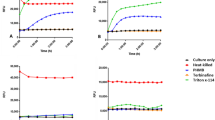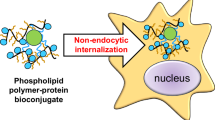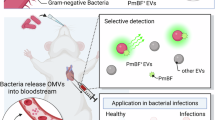Abstract
Polymyxin B (PMB) acts selectively on Gram-negative bacteria by electrostatic and hydrophobic interactions with anionic cell envelope components such as phospholipids and lipopolysaccharides. In this study, PMB was shown to exhibit marked fungicidal activity against yeasts and filamentous fungi in combination with ionophores such as salinomycin (SAM) and monensin (MON), which can selectively interact with monovalent cations. Ca2+-selective ionophores, A23187 and ionomycin, were absolutely ineffective in enhancing the fungicidal activity of PMB. SAM and MON increased the rate of cellular uptake of PMB possibly in favor of its intracellular action on the organelle. PMB could indeed directly disrupt the spherical membrane-enclosed architecture of the isolated vacuoles equally in the absence and presence of the ionophores. The loss of energy barrier for transmembrane transport of monovalent cations is considered to be a cause of enhanced incorporation of larger cationic compounds such as PMB across fungal plasma membrane.
Similar content being viewed by others
Log in or create a free account to read this content
Gain free access to this article, as well as selected content from this journal and more on nature.com
or
References
Vaara, M. Analytical and preparative high-performance liquid chromatography of the papain-cleaved derivative of polymyxin B. J. Chromatogr. 441, 423–430 (1988).
Hancock, R. E. Peptide antibiotics. Lancet 349, 418–422 (1997).
Boguslawski, G. Effects of polymyxin B sulfate and polymyxin B nonapeptide on growth and permeability of the yeast Saccharomyces cerevisiae. Mol. Gen. Genet. 199, 401–405 (1985).
Moneib, N. A. In-vitro activity of commonly used antifungal agents in the presence of rifampin, polymyxin B and norfloxacin against Candida albicans. J. Chemother. 7, 525–529 (1995).
Schwartz, S. N., Medoff, G., Kobyashi, G. S., Kwan, C. N. & Schlessinger, D. Antifungal properties of polymyxin B and its potentiation of tetracycline as an antifungal agent. Antimicrob. Agents Chemother. 2, 36–46 (1972).
Ogita, A., Nagao, Y., Fujita, K. & Tanaka, T. Amplification of vacuole-targeting fungicidal activity of antibacterial antibiotic polymyxin B by allicin, an allyl sulfur compound from garlic. J. Antibiot. 60, 511–518 (2007).
Ogita, A., Matsumoto, K., Fujita, K., Usuki, Y., Hatanaka, Y. & Tanaka, T. Synergistic fungicidal activities of amphotericin B and N-methyl-N″-dodecylguanidine: a constituent of polyol macrolide antibiotic niphimycin. J. Antibiot. 60, 27–35 (2007).
Nakayama, K., Yamaguchi, T., Doi, T., Usuki, Y., Taniguchi, M. & Tanaka, T. Synergistic combination of direct plasma membrane damage and oxidative stress as a cause of antifungal activity of polyol macrolide antibiotic niphimycin. J. Biosci. Bioeng. 94, 207–211 (2002).
Usuki, Y., Matsumoto, K., Inoue, T., Yoshioka, K., Iio, H. & Tanaka, T. Structure-activity relationship studies on niphimycin, a guanidylpolyol macrolide antibiotic. Part 1: the role of the N-methyl-N″-alkylguanidinium moiety. Bioorg. Med. Chem. Lett. 16, 1553–1556 (2006).
Ogita, A., Fujita, K., Taniguchi, M. & Tanaka, T. Enhancement of the fungicidal activity of amphotericin B by allicin, an allyl-sulfur compound from garlic, against the yeast Saccharomyces cerevisiae as a model system. Planta Med. 72, 1247–1250 (2006).
Lindsay, D. S. & Blagburn, B. L. Antiprotozoan. Antiprotozoan drugs. In Veterinary Pharmacology and Therapeutics (ed Adams, H. R.) 969–983 (Iowa State University Press, Amsterdam, 1995).
Westley, J. W. Chemical transformations of polyether antibiotics. In Polyether Antibiotics: Naturally Occurring Acid Ionophores Chemistry Vol 2 (ed Westley, J. W.) 51–87 (Marcel Dekker Inc., New York, 1983).
Haney, M. E. Jr. & Hoehn, M. M. Monensin, a new biologically active compound. I. Discovery and isolation. Antimicrob. Agent Chemother. 7, 349–352 (1967).
Butaye, P., Devriese, L. A. & Haesebrouck, F. Antimicrobial growth promoters used in animal feed: effects of less well known antibiotics on Gram-positive bacteria. Clinic Microbiol. Rev. 16, 175–188 (2003).
Takahashi, M., Shibata, M. & Niki, E. Estimation of lipid peroxidation of live cells using a fluorescent probe, diphenyl-1-pyrenylphosphine. Free Radic. Biol. Med. 31, 164–174 (2001).
Ogita, A., Fujita, K., Taniguchi, M. & Tanaka, T. Dependence of synergistic fungicidal activity of Cu2+ and allicin, an allyl sulfur compound from garlic, on selective accumulation of the ion in the plasma membrane fraction via allicin-mediated phospholipid peroxidation. Planta Med. 72, 875–880 (2006).
Conradt, B., Shaw, J., Vida, T., Emr, S. & Wickner, W. In vitro reactions of vacuole inheritance in Saccharomyces cerevisiae. J. Cell Biol. 119, 1469–1479 (1992).
Ohsumi, Y. & Anraku, Y. Active transport of basic amino acids driven by a proton motive force in vacuolar membrane vesicles of Saccharomyces cerevisiae. J. Biol. Chem. 256, 2079–2082 (1981).
Tabuchi, M. et al. Vacuolar protein sorting in fission yeast: cloning, biosynthesis, transport, and processing of carboxypeptidase Y from Schizosaccharomyces pombe. J. Bacteriol. 179, 4179–4189 (1997).
Vida, T. A. & Emr, S. D. A new vital stain for visualizing vacuolar membrane dynamics and endocytosis in yeast. J. Cell Biol. 128, 779–792 (1995).
Arnold, T. M., Forrest, G. N. & Messember, K. J. Polymyxin antibiotics for Gram-negative infections. Am. J. Health Syst. Pharm. 64, 819–826 (2007).
Liu, C. & Hermann, T. E. Characterization of ionomycin as a calcium ionophore. J. Biol. Chem. 253, 5892–5894 (1978).
Reed, P. W. & Lardy, H. A. A23187: a divalent cation ionophore. J. Biol. Chem. 247, 6970–6977 (1972).
Ogita, A. et al. Synergistic fungicidal activity of Cu2+ and allicin, an allyl sulfur compound from garlic, and its relation to the role of alkyl hydroperoxide reductase 1 as a cell surface defense in Saccharomyces cerevisiae. Toxicology 215, 205–213 (2005).
Mitani, M., Yamanishi, T., Miyazaki, Y. & Otake, N. Salinomycin effects on mitochondrial ion translocation and respiration. Antimicrob. Agents Chemother. 9, 655–660 (1976).
Machida, K., Tanaka, T., Fujita, K. & Taniguchi, M. Farnesol-induced generation of reactive oxygen species via indirect inhibition of mitochondrial electron transport chain in the yeast Saccharomyces cerevisiae. J. Bacteriol. 180, 4460–4465 (1998).
Machida, K. & Tanaka, T. Farnesol-induced generation of reactive oxygen species dependent on mitochondrial transmembrane potential hyperpolarization mediated by F0F1-ATPase in yeast. FEBS Lett. 462, 108–112 (1999).
Wickner, W. Yeast vacuoles and membrane fusion pathways. EMBO J. 21, 1241–1247 (2002).
Zinser, E., Sperka-Gottlieb, C. D., Fasch, E. V., Kohlwein, S. D., Paltauf, F. & Daum, G. Phospholipid synthesis and lipid composition of subcellular membranes in the unicellular eukaryote Saccharomyces cerevisiae. J. Bacteriol. 173, 2026–2034 (1991).
Hecktberger, P., Zinser, E., Saf, R., Hummel, K., Paltauf, F. & Daum, G. Characterization, quantification, and subcellular localization of inositol-containing sphingolipids of the yeast, Saccharomyces cerevisiae. Eur. J. Biochem. 225, 641–649 (1994).
Acknowledgements
This work was supported in part by a Grant-in-Aid for Scientific Research (C) (No. 20580083) from Japan Society for the Promotion of Science.
Author information
Authors and Affiliations
Corresponding author
Rights and permissions
About this article
Cite this article
Ogita, A., Konishi, Y., Borjihan, B. et al. Synergistic fungicidal activities of polymyxin B and ionophores, and their dependence on direct disruptive action of polymyxin B on fungal vacuole. J Antibiot 62, 81–87 (2009). https://doi.org/10.1038/ja.2008.13
Received:
Accepted:
Published:
Issue date:
DOI: https://doi.org/10.1038/ja.2008.13
Keywords
This article is cited by
-
Enhancement effect of N-methyl-N″-dodecylguanidine on the vacuole-targeting fungicidal activity of amphotericin B against the pathogenic fungus Candida albicans
The Journal of Antibiotics (2011)
-
The vacuole-targeting fungicidal activity of amphotericin B against the pathogenic fungus Candida albicans and its enhancement by allicin
The Journal of Antibiotics (2009)



